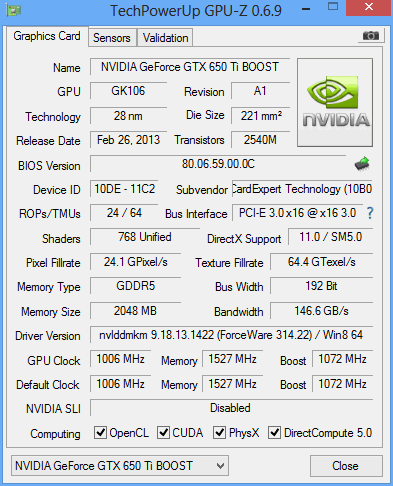Index
- Gainward GTX 650 Ti Boost Golden Sample reviewed
- Packaging
- A closer look at GS
- Testbed
- Nvidia Experience
- Crysis 3
- Hitman Absolution
- Metro 2033
- Sleeping Dogs
- Dirt Showdown
- 3DMark 11
- 3DMark
- Unigine Valley
- Unigine Heaven
- Gainward ExperTool II & Overclocking
- Thermals, Noise, Consumption
- Conclusion
- All Pages


Review: GTX 650 with wings
We already established that the new GTX 650 Ti Boost is a rather special part of the GTX 650 series. In fact, it is so different that it could have ended up with a different brand altogether. While plain GTX 650 cards struggle in 1080p gaming, the new Boost card seems more than able to churn out playable framerates in relatively fresh titles. Nvidia decided to use the Boost moniker because the new card features GPU Boost, which is missing from other GTX 650 cards. As the name suggests, GPU Boost allows the card to boost GPU clocks depending on load and temperature.
Today we will look at Gainward’s GTX 650 Ti Boost Golden Sample which comes with slightly upped performance thanks to some factory overclocking. It also features one specially designed dual-slot cooler which comes with two heatpipes and two 75mm fans. Gainward factory overclock is not as high as we’ve come to expect from a Golden Sample card, but it is possible that Gainward is saving a faster design for its Goes Like Hell series. The Golden Sample card features a base GPU clock of 1006MHz, while GPU Boost ups the clock to 1072MHz. The reference GTX 650 Ti Boost stock clock is 980MHz, with a typical boost clock of 1033MHz.
A simple clock boost with no additional changes would not have ensured the new Boost card a significant performance edge over the GTX 650 Ti. Luckily Nvidia had a few other tricks up its sleeve, so it widened the 128-bit memory bus to 192 bits, greatly improving bandwidth on the new card. Thanks to the new bus and faster memory chips, the new card has 66 percent more bandwidth compared to the plain GTX 650 Ti. The memory on the Golden Sample card is overclocked by 25MHz (effectively 100MHz), so even in terms of memory bandwidth it has a slight edge over the reference Boost card. The memory is easily overclockable, too.
The table below show specifications for the reference GTX 650 Ti Boost.
| GTX 650 Ti Boost | |
| Base Clock Speed | 980MHz |
| Typical Boost Clock | 1033MHz |
| OC Boost | 1100MHz+ |
| CUDA Cores | 768 |
| SMX Units | 4 |
| Memory speed | 6008MHz |
| Memory Subset | 192-bit |
| Memory Controller | 3x64-bit |
| Memory Capacity | 2048MB GDDR5 |
| Typical Draw (non-TDP Apps) | 115W |
| Typical Draw (non-TDP Apps) with slider at 110% | 127W |
| Power Connectors | 1x 6-pin PCIe |
| Length | 9.5” |
| Display outputs | 2x dual-link DVIs |
| HDMI | |
| DisplayPort |
Following the introduction of the GTX 650 Ti Boost, Nvidia’s complete Geforce 6xx lineup consists of the following cards:
Geforce GTX TITAN (GK110)
Geforce GTX 690 (2xGK104)
Geforce GTX 680 (GK104)
Geforce GTX 670 (GK104)
Geforce GTX 660 Ti (GK104)
Geforce GTX 660 (GK106)
Geforce GTX 650 Ti BOOST (GK106)
Geforce GTX 650 Ti (GK106)
Geforce GTX 650 (GK107)
Geforce GT 640 (GK107)
Geforce GT 630 (re-branded Geforce GT 440)
Geforce GT 620
Geforce GT 610



